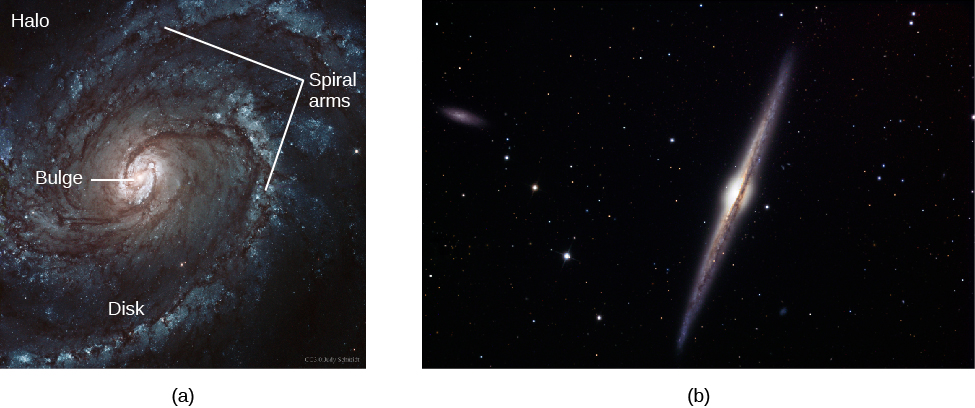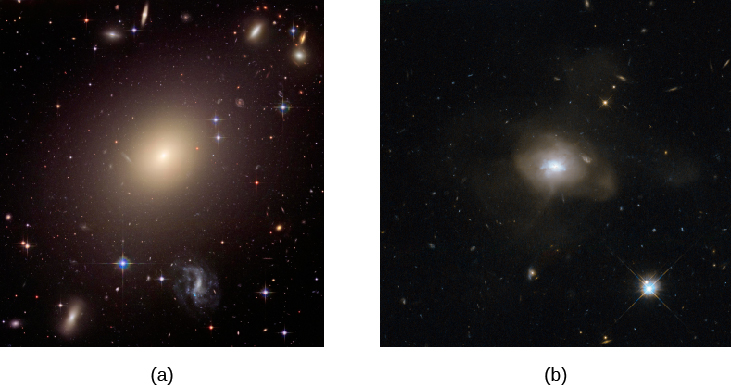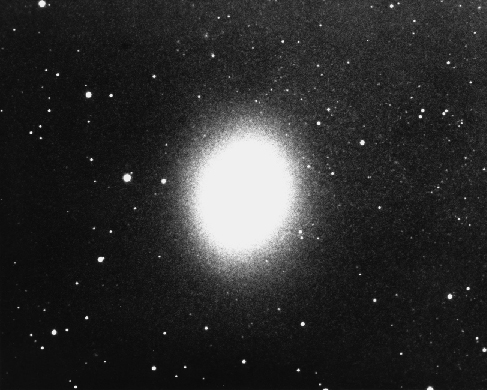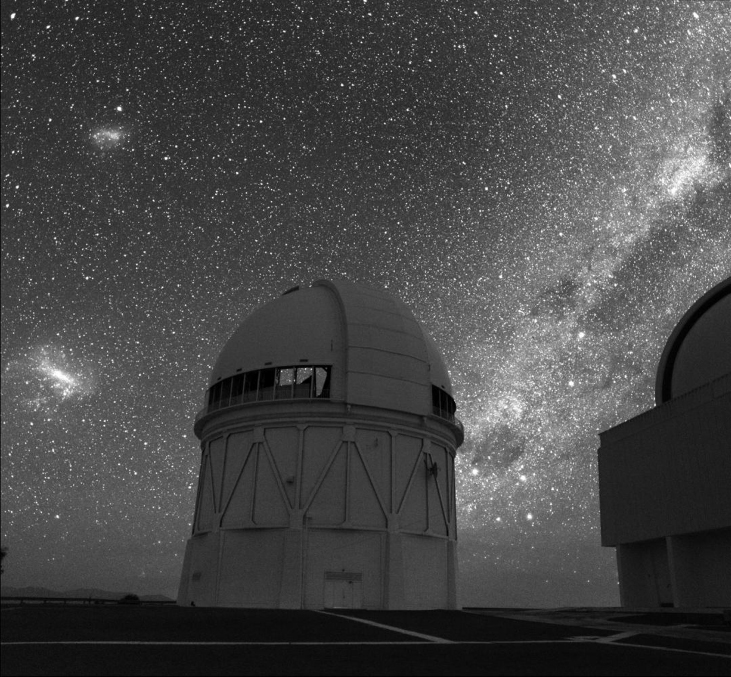12.3 The Classification of Galaxies
Our own Galaxy and the Andromeda galaxy are typical, large spiral galaxies (see images below). They consist of a central bulge, a halo, a disk, and spiral arms. Interstellar material is usually spread throughout the disks of spiral galaxies. Bright emission nebulae and hot, young stars are present, especially in the spiral arms, showing that new star formation is still occurring. The disks are often dusty, which is especially noticeable in those systems that we view almost edge on as shown in Figure 12.10.
Spiral Galaxies

Credit a: Messier 100 galaxy Hubble by Hubble Legacy Archive, NASA, ESA, and Judy Schmidt, ESA Standard License.
Credit b: NGC 4565 and 4562 by “Jschulman555”/ Wikimedia, CC BY 4.0.
In galaxies that we see face on, the bright stars and emission nebulae make the arms of spirals stand out like those of a pinwheel on the fourth of July. Open star clusters can be seen in the arms of nearer spirals, and globular clusters are often visible in their halos. Spiral galaxies contain a mixture of young and old stars, just as the Milky Way does. All spirals rotate, and the direction of their spin is such that the arms appear to trail much like the wake of a boat.
About two-thirds of the nearby spiral galaxies have boxy or peanut-shaped bars of stars running through their centres as shown in Figure 12.11. Showing great originality, astronomers call these galaxies barred spirals.
Barred Spiral Galaxy

Barred Spiral Galaxy NGC 1300 by NASA, ESA, and the Hubble Heritage Team(STScI/AURA), NASA Media License.
In both barred and unbarred spiral galaxies, we observe a range of different shapes. At one extreme, the central bulge is large and luminous, the arms are faint and tightly coiled, and bright emission nebulae and supergiant stars are inconspicuous. Hubble, who developed a system of classifying galaxies by shape, gave these galaxies the designation Sa. Galaxies at this extreme may have no clear spiral arm structure, resulting in a lens-like appearance (they are sometimes referred to as lenticular galaxies). These galaxies seem to share as many properties with elliptical galaxies as they do with spiral galaxies
At the other extreme, the central bulge is small and the arms are loosely wound. In these Sc galaxies, luminous stars and emission nebulae are very prominent. Our Galaxy and the Andromeda galaxy are both intermediate between the two extremes. Photographs of spiral galaxies, illustrating the different types, are shown in Figure 12.12, along with elliptical galaxies for comparison.
Hubble Classification of Galaxies

The Hubble Tuning Fork by NASA, ESA, ESA Standard License.
The luminous parts of spiral galaxies appear to range in diameter from about 20,000 to more than 100,000 light-years. Recent studies have found that there is probably a large amount of galactic material that extends well beyond the apparent edge of galaxies. This material appears to be thin, cold gas that is difficult to detect in most observations.
From the observational data available, the masses of the visible portions of spiral galaxies are estimated to range from 1 billion to 1 trillion Suns (109 to 1012MSun). The total luminosities of most spirals fall in the range of 100 million to 100 billion times the luminosity of our Sun (108 to 1011LSun). Our Galaxy and M31 are relatively large and massive, as spirals go. There is also considerable dark matter in and around the galaxies, just as there is in the Milky Way; we deduce its presence from how fast stars in the outer parts of the Galaxy are moving in their orbits.
Elliptical galaxies consist almost entirely of old stars and have shapes that are spheres or ellipsoids (somewhat squashed spheres) as shown in Figure 12.13 They contain no trace of spiral arms. Their light is dominated by older reddish stars. In the larger nearby ellipticals, many globular clusters can be identified. Dust and emission nebulae are not conspicuous in elliptical galaxies, but many do contain a small amount of interstellar matter.
Elliptical Galaxies

Credit a: Hubble Illuminates Cluster of Diverse Galaxies by NASA, ESA, and The Hubble Heritage Team (STScI/AURA), NASA Media License.
Credit b: Hubble Finds the Calm after the Galactic Storm by NASA/Hubble, NASA, NASA Media Licence.
Elliptical galaxies show various degrees of flattening, ranging from systems that are approximately spherical to those that approach the flatness of spirals. The rare giant ellipticals (for example, ESO 325-G004 in Figure 12.13) reach luminosities of 1011LSun. The mass in a giant elliptical can be as large as 1013MSun. The diametres of these large galaxies extend over several hundred thousand light-years and are considerably larger than the largest spirals. Although individual stars orbit the centre of an elliptical galaxy, the orbits are not all in the same direction, as occurs in spirals. Therefore, ellipticals don’t appear to rotate in a systematic way, making it difficult to estimate how much dark matter they contain.
We find that elliptical galaxies range all the way from the giants, just described, to dwarfs, which may be the most common kind of galaxy. Dwarf ellipticals (sometimes called dwarf spheroidals) escaped our notice for a long time because they are very faint and difficult to see. An example of a dwarf elliptical is the Leo I Dwarf Spheroidal galaxy shown in Figure 12.14. The luminosity of this typical dwarf is about equal to that of the brightest globular clusters.
Intermediate between the giant and dwarf elliptical galaxies are systems such as M32 and M110, the two companions of the Andromeda galaxy. While they are often referred to as dwarf ellipticals, these galaxies are significantly larger than galaxies such as Leo I.
Dwarf Elliptical Galaxy

M32, NGC 221 by NOAO/AURA/NSF, CC BY 4.0.
Hubble classified galaxies that do not have the regular shapes associated with the categories we just described into the catchall bin of an irregular galaxy, and we continue to use his term. Typically, irregular galaxies have lower masses and luminosities than spiral galaxies. Irregular galaxies often appear disorganized, and many are undergoing relatively intense star formation activity. They contain both young population I stars and old population II stars.
The two best-known irregular galaxies are the Large Magellanic Cloud and Small Magellanic Cloud, as shown in Figure 12.15, which are at a distance of a little more than 160,000 light-years away and are among our nearest extragalactic neighbours. Their names reflect the fact that Ferdinand Magellan and his crew, making their round-the-world journey, were the first European travellers to notice them. Although not visible from the United States and Europe, these two systems are prominent from the Southern Hemisphere, where they look like wispy clouds in the night sky. Since they are only about one-tenth as distant as the Andromeda galaxy, they present an excellent opportunity for astronomers to study nebulae, star clusters, variable stars, and other key objects in the setting of another galaxy. For example, the Large Magellanic Cloud contains the 30 Doradus complex (also known as the Tarantula Nebula), one of the largest and most luminous groups of supergiant stars known in any galaxy.
4-Meter Telescope at Cerro Tololo Inter-American Observatory Silhouetted against the Southern Sky

Blanco Telescope silhouetted against night sky by Roger Smith/NOAO/AURA/NSF, CC BY 4.0.
The Small Magellanic Cloud is considerably less massive than the Large Magellanic Cloud, and it is six times longer than it is wide. This narrow wisp of material points directly toward our Galaxy like an arrow. The Small Magellanic Cloud was most likely contorted into its current shape through gravitational interactions with the Milky Way. A large trail of debris from this interaction between the Milky Way and the Small Magellanic Cloud has been strewn across the sky and is seen as a series of gas clouds moving at abnormally high velocity, known as the Magellanic Stream. We will see that this kind of interaction between galaxies will help explain the irregular shapes of this whole category of small galaxies,
Attribution
“26.2 Types of Galaxies” from Douglas College Astronomy 1105 by Douglas College Department of Physics and Astronomy, is licensed under a Creative Commons Attribution 4.0 International License, except where otherwise noted. Adapted from Astronomy 2e.

